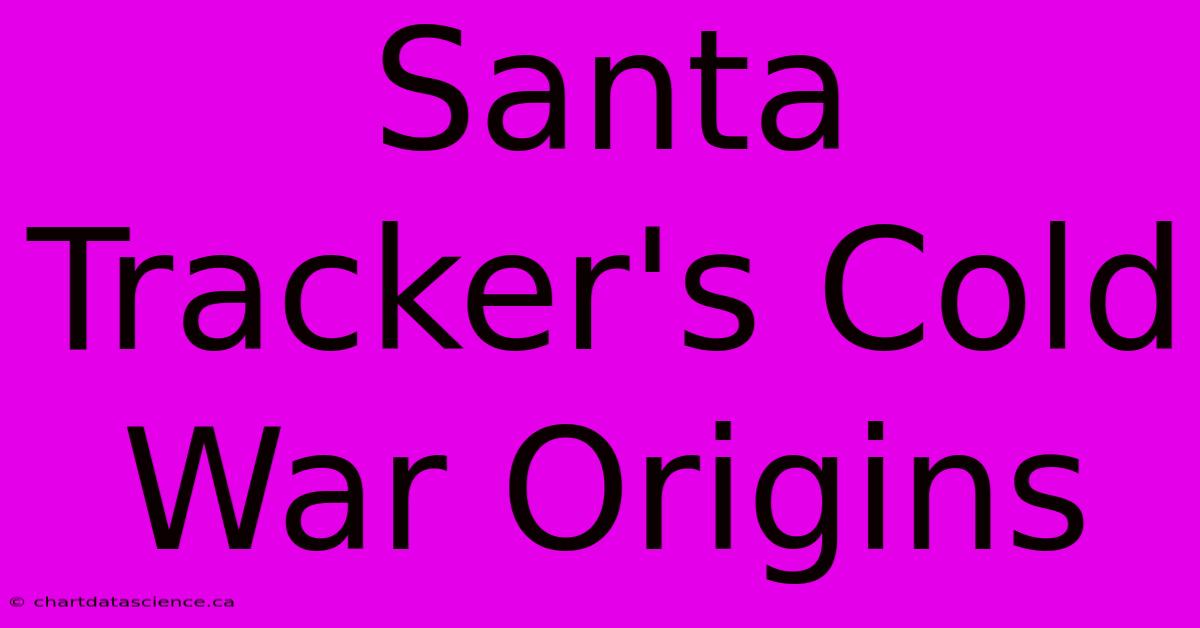Santa Tracker's Cold War Origins

Discover more detailed and exciting information on our website. Click the link below to start your adventure: Visit My Website. Don't miss out!
Table of Contents
Santa Tracker's Cold War Origins: From NORAD to Google
The jolly image of Santa Claus tracking his global journey on Christmas Eve is now a beloved holiday tradition, readily accessible through websites and apps. But this seemingly modern marvel has surprisingly deep roots, stretching back to the Cold War era and a serendipitous confluence of events. Understanding its origins reveals a fascinating intersection of military technology, public relations, and the enduring magic of Christmas.
The Accidental Beginning: A Misdial and a Misunderstanding
The story begins in 1955 with a Sears Roebuck & Co. advertisement featuring a phone number for children to call Santa. However, a typographical error led to the number being connected instead to the Continental Air Defense Command (CONAD), the predecessor to the North American Aerospace Defense Command (NORAD). Instead of being disappointed, Colonel Harry Shoup, an officer on duty that Christmas Eve, responded with remarkable ingenuity. He and his team played along, providing children with Santa's location based on their own radar systems.
NORAD Takes the Reins: Military Might Meets Christmas Spirit
This unexpected event became an annual tradition. What began as a playful response quickly evolved into a carefully orchestrated public relations campaign. NORAD, inheriting the responsibility from CONAD, leveraged its powerful radar technology to "track" Santa's journey, transforming a potential embarrassment into a heartwarming and globally recognized holiday event. This clever initiative served a secondary purpose: it subtly showcased the power and capabilities of NORAD’s sophisticated surveillance systems in a positive, family-friendly context, thereby countering some of the negative perceptions associated with military technology during the Cold War.
The Evolution of Technology: From Radar to Satellites
Over the decades, the Santa tracking operation has mirrored technological advancements. What once relied on ground-based radar gradually incorporated satellite tracking and other advanced technologies. This continuous technological upgrade showcased NORAD's ability to adapt and innovate, further reinforcing its public image. The integration of modern technologies also ensured the continuation of the tradition, keeping it relevant for new generations.
The Digital Age: From Phone Calls to Interactive Websites
The advent of the internet marked another significant transformation. NORAD transitioned from handling phone calls to providing real-time Santa tracking on its website. This digital leap brought the tradition to a global audience, expanding its reach exponentially. The interactive nature of the online trackers, featuring animations, games, and other engaging features, added another layer of enchantment to the experience.
Google's Contribution: Expanding the Reach
In recent years, technology giants like Google have collaborated with NORAD, further enhancing the digital Santa tracking experience. This partnership leverages Google's vast technological resources, ensuring that the tradition remains accessible and engaging for millions worldwide.
The Enduring Legacy: A Cold War Relic with Modern Appeal
The Santa Tracker's origins in the Cold War era demonstrate the unexpected ways in which historical events can shape modern traditions. What began as a simple mistake evolved into a globally celebrated event, showcasing the power of adaptability, ingenuity, and the enduring appeal of Christmas magic. The tradition's evolution, mirroring technological progress, highlights its relevance in an increasingly digital world. More than just a Christmas activity, the Santa tracker represents a unique blend of military history, public relations prowess, and the universal joy of the holiday season. Its continuous adaptation ensures its future as a beloved holiday tradition for generations to come. The story of the Santa Tracker serves as a powerful reminder that even the most unexpected events can lead to heartwarming and enduring legacies.

Thank you for visiting our website wich cover about Santa Tracker's Cold War Origins. We hope the information provided has been useful to you. Feel free to contact us if you have any questions or need further assistance. See you next time and dont miss to bookmark.
Also read the following articles
| Article Title | Date |
|---|---|
| Best Christmas Wishes 2024 50 | Dec 24, 2024 |
| Undiscovered Dickens Christmas Carols | Dec 24, 2024 |
| Real Life Violence In Squid Games World | Dec 24, 2024 |
| Norad Tracks Santa Real Time Updates | Dec 24, 2024 |
| Festivus Traditions A Happy Festivus Celebration | Dec 24, 2024 |
